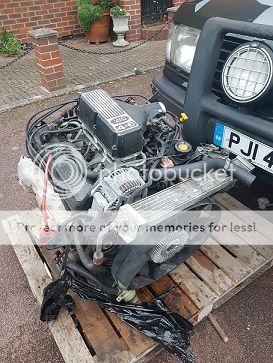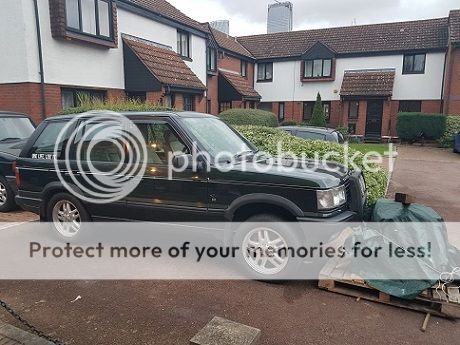It lives again! Not at all as straightforward as expected but it looks like we've got there in the end. The owner of the car, Mick, works 4 days on, 4 days off and the only time I could get down there with the engine crane was last weekend (12th Oct). Dave shipped the engine on Monday, Mick was at home Sunday to Wednesday (and had taken Saturday and Sunday off work to get stuck in) and it was expected that the engine would arrive on Wednesday. But it didn't. Contacted Dave who said he would chase the courier and was told it would be delivered Thursday or Friday at the latest. Fortunately, it was being delivered to Mick's mother’s house (where there was more room so the transplant was going to be done there anyway) and she would be at home. Mick then gets a phone call on Friday morning to say it would be delivered on Monday..... Turns out the original courier had picked it up but then couldn't fit it into their delivery schedule so had subbed the delivery out to another company. The only option then was to collect it from their depot and Mick ended up getting a man with a van to pick it up for him so it was ready to go for Saturday.
I got there Saturday morning to be greeted by a complete, and I do mean complete, 4.6 motor sitting on a pallet. It had all the ancillaries still attached, alternator, starter, exhaust manifolds, power steering pump, AC compressor, oil cooler and hoses, water pump, viscous and fan and engine wiring loom. Nothing damaged (or so it appeared). Certainly looked a big bugger sitting there! Mick had been spending time stripping everything off the old engine so that looked pretty naked sitting in the hole. We got stuck in for the most miserable engine swap ever. Despite the garden gazebo over the working area, it was raining, constantly. The gazebo wasn't doing much, the tarp and cardboard under car turned into a gooey mass and we both (and Mick's wife, Sue) were absolutely soaked. The bellhousing bolts had been done up by a tame gorilla at Lode Lane when it had been put together in 1996 so while the bottom two were simple enough, and the top two could be got at through the hole where the ignition coils had lived, the two further up on each side needed multiple socket extensions, a pair of universal joints and a breaker bar before they came loose. Then there's the bolts on the flex plate. RAVE says 33 ft/lbs and Loctite and there must have been a hell of a lot of Loctite. To get better access, the sump came off but even then, only 3 of the 4 came out. The last one needed a 1/2" Irwin socket before it came undone with a healthy crack. So finally, after about 5 hours of swearing at it, the old engine was lifted out (not made any easier by the front bullbar meaning it had to be lifted that much higher).

The Spacer behind the flex plate was swapped over and we figured taking the fan off would give us a bit more space to play with. Would it shift? Would it hell, despite my home made bar to stop it turning and belting the fan spanner with a club hammer. So we decided the engine was going back in complete with fan on the front.
We had the gearbox angled upwards with a jack under it (and a lump of wood jammed in the hole at the bottom to stop the torque converter falling out) so the theory was that we could lower the engine in place angled upwards, bolt it to the bellhousing then lower it down onto the engine mounts. That was the theory anyway but with a complete engine, getting it hanging so the rear was down meant that the centre point had to be towards the front. With the lifting brackets at the rear right and front left, that then meant the engine hung right side down. So it would go in the hole but the RH engine mount was far too low for it to be moved into place. With it tilted the plenum was hitting the top of the bulkhead so it couldn’t go back far enough to reach the bellhousing. By now it was gone 6pm, we were all soaked to the skin and completely pissed off with the whole thing. Time to call it a day, so I went home.
Sunday morning and I drove back to Mick’s to continue. This time I had bought a couple more jacks, some lengths of fencepost and some more ratchet straps with me. Mick and Sue had already started trying to get it in place but it was still sitting lopsided. We lowered it down so the crane wasn’t supporting the weight and took off the plenum and upper manifold. That way we could release the ignition coils to get access to the top bellhousing bolts and the plenum wouldn’t be jamming on the bulkhead. We rearranged the fixings, adding a couple of ratchet straps so we could adjust the angle and started again. This time, with the aid of a bottle jack and lump of 4x4 fencepost under one rear corner, we could get the angle right and finally, the engine slid back and mated with the bellhousing. Bolts in, me underneath with Mick laying across the top of the engine doing the top ones. Flex plate bolts were put back in, engine mounts bolted up and, while I was under there, I figured I would reconnect the lambda sensors. Then found a problem. The car was a 96 with the black plug on the lambda sensors while the engine had come from a 98 with the grey plug and they wouldn’t connect. Bugger, that will need a bit of thought.
The top end of the engine was put back together only using the plenum and throttle body from the original engine. The 96 has the tube from the purge valve going to the upper inlet manifold while the 98 has it going to the throttle body. Mick’s original engine also had a multipoint LPG conversion so the upper manifold also had the additional vacuum take offs so these were plugged for the time being. The plan is to get it running initially on petrol and then re-install the LPG system later.
Connected up the loom (except for the lambda sensors of course), coolant hoses, including the new throttle body heater hose that had caused all the problems in the first place, fitted the radiator, filled the cooling system with plain water initially (no point in filling it with coolant if there’s a possibility it is all going to pour out of somewhere), bled the air out, filled the engine with oil and it all looked ready to go. Fitted the battery and plugged the Nanocom in. The ECU was set for a 4.0 litre engine for Europe so I thought I could get clever. Set it for 4.6 (as it now had a 4.6 in it) and Australia as Oz spec cars don’t have lambda sensors so it wouldn’t miss something it wouldn’t be looking for. Reset the adaptive values and all should be ready to go. Told Mick to turn the key to spin it over and make sure we had oil pressure and it fired up instantly! That should have been a cause for rejoicing but as we hadn’t connected the exhaust downpipes to the manifolds it was a little on the loud side in a quiet residential cul-de-sac. Sounded bloody gorgeous though. So, all we need is the exhaust reconnecting and we should be in business.
Easier said than done though. We all know what a pig the manifold studs can be to undo and we found that the RH manifold had one sheared off stud in it (but two usable M10 threaded holes) while all three were sheared off on the LH one. With a lack of grinder or decent drills, we decided to call it a day and Mick would sort that out over the next couple of days. All sorted, just got to run it to check for any coolant or oil leaks and the job is done. Or so we thought.......
Peterborough, Cambs
- '93 Range Rover Classic 4.2 LSE, sold
- '97 Range Rover 4.0SE, in Oxford Blue with a sort of grey/blue leather interior sold as two is plenty.....
- '96 4.6HSE Ascot - now sold
- '98 4.0SE in Rioja Red
'98 Ex-Greater Manchester Police motorway patrol car, Range Rover P38 4.0, in Chawton white - the everyday car
All running perfectly on LPG
- Proud to be a member of the YCHJCYA2PDTHFH club.




